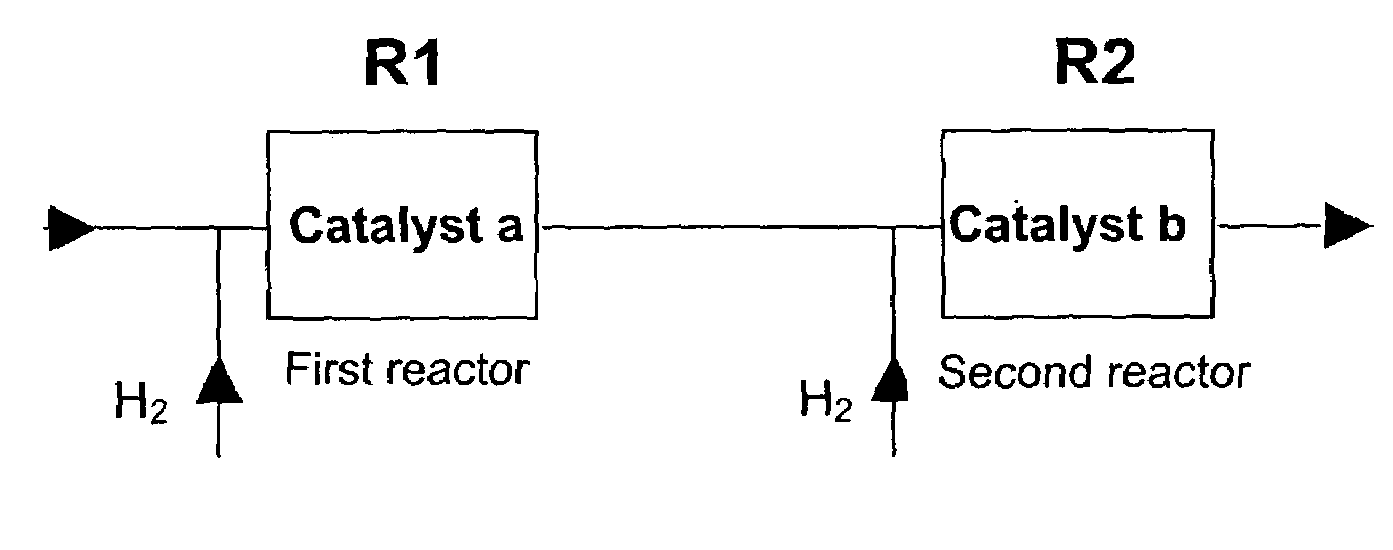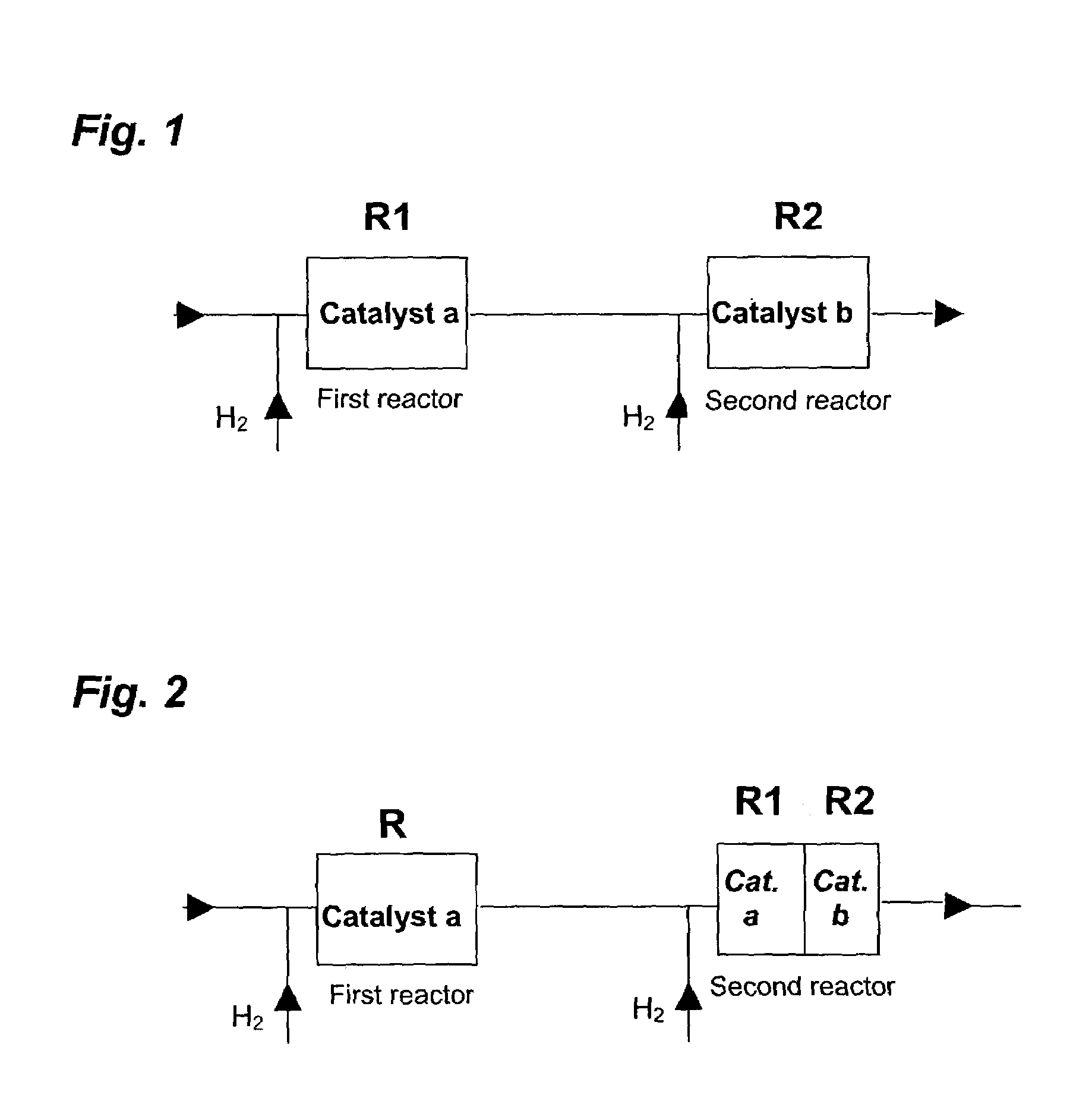Dual bed process using two different catalysts for selective hydrogenation of acetylene and dienes
a technology of selective hydrogenation and catalyst, which is applied in the field of selective hydrogenation of acetylene, methyl acetylene, propadiene, butadienes, can solve the problems of reducing catalyst life, reducing catalyst life, and undesirable saturates of both saturates and green oil, so as to maintain or improve the conversion of acetylene, reducing the need for hydrogen, and reducing the need for oligomers and saturates
- Summary
- Abstract
- Description
- Claims
- Application Information
AI Technical Summary
Benefits of technology
Problems solved by technology
Method used
Image
Examples
example i
[0059]This Example illustrates the preparation of catalysts used in the present invention.
[0060]Catalyst A: 0.6% Pt, 2.4% Ru on Al2O3
[0061]Theta-alumina (4.77 g; SBa-90, available from Sasol Limited) was mixed with 20 ml de-ionized H2O and a slurry was obtained. Next, 0.06 g H2PtCl6.H2O was dissolved in 20 ml de-ionized H2O. Then, 0.25 g RuCl3.xH2O was dissolved in 40 ml de-ionized H2O. The platinum solution was mixed with the ruthenium solution. The solution containing both metals was added to the alumina slurry. After 1 hour stirring, the slurry was gently heated until most of the water was removed. The resulting paste was dried in a vacuum oven for 2 hours. The remaining powder was calcined under air for 2 hours at 120° C. and 4 hours at 450° C.
[0062]Catalyst B: 0.03% Pd, 0.18% Ag on Al2O3
[0063]Theta-alumina (19.95 g; MI-407, available from W.R. Grace & Co.) was mixed with 50 ml de-ionized H2O and a slurry was obtained. Next, 0.01 g Pd(NO3)2.xH2O and 0.06 g AgNO3 were dissolved...
example ii
[0072]This Example shows the performance of a bimetallic, low green oil make catalyst that could be used in the first reaction zone R1. The catalyst was evaluated under the following conditions: T(catalyst)=100° C., P=300 psig, GHSV=4500, H2 / C2H2 feed ratio=1.1. The hydrocarbon feed contained 1.65 mole % acetylene, 70 mole % ethylene, and balance nitrogen. Test results are given in Table 1 below.
[0073]
TABLE 1CatalystC2H2C2H4C2H6 sel.H2 conv.GO sel.Test #(Ref. #)conv. (%)sel. (%)(%)(%)(%)1A55.828.461.110010.5
[0074]Under the same conditions, the state-of-the-art Pd / Ag-based commercial catalyst G-58C, from Süd Chemie, Inc., gives about 2.5–3 times higher green oil selectivity; please see test #2 in Table 2, below.
[0075]Potential Pd-based catalysts for second reaction zone R2 are displayed in Table 2 below with their test results. They were evaluated under similar conditions to those used for first reaction zone R1, i.e. T(catalyst)=100° C., P=300 psig, GHSV=4500, H2 / C2H2 feed ratio=1.3...
example iii
[0080]This Example shows the performance of trimetallic, low green oil make catalysts that could be used in the first reaction zone R1. They were evaluated under the same conditions as the R1 bimetallic catalyst from Example II. They could be combined with any of the second reaction zone R2 catalysts depicted in Example II. The test results are given in Table 3 below.
[0081]
TABLE 3CatalystC2H2C2H4C2H6H2 conv.GO sel.Test #(Ref. #)conv. (%)sel. (%)sel. (%)(%)(%)6E56.344.24687.29.97F52.518.571.61009.8
[0082]Attention will now turn to selective acetylene hydrogenation with reference to the process schematically illustrated in FIG. 2. However, it will again be appreciated that the findings and observations could be applied to MAPD and BD selective hydrogenation as well. The embodiment described with respect to FIG. 2 would be particularly suited to retrofitting the method of the present invention into a plant already having two or more reactors of fixed size.
[0083]In one non-limiting embod...
PUM
| Property | Measurement | Unit |
|---|---|---|
| pressure | aaaaa | aaaaa |
| pressure | aaaaa | aaaaa |
| inlet temperature | aaaaa | aaaaa |
Abstract
Description
Claims
Application Information
 Login to View More
Login to View More - R&D
- Intellectual Property
- Life Sciences
- Materials
- Tech Scout
- Unparalleled Data Quality
- Higher Quality Content
- 60% Fewer Hallucinations
Browse by: Latest US Patents, China's latest patents, Technical Efficacy Thesaurus, Application Domain, Technology Topic, Popular Technical Reports.
© 2025 PatSnap. All rights reserved.Legal|Privacy policy|Modern Slavery Act Transparency Statement|Sitemap|About US| Contact US: help@patsnap.com



